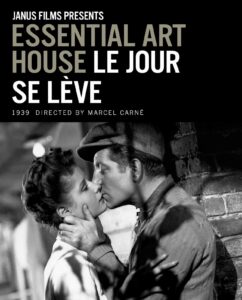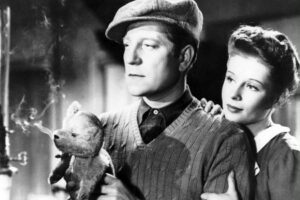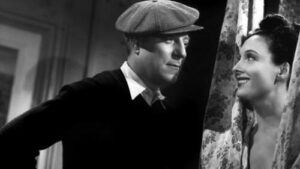“Le jour se lève” – a Masterpiece of French Poetic Realism

Title: “Le jour se lève”
Release Date: 1939
Director: Marcel Carné
Cast: Jean Gabin, Jules Berry, Jacqueline Laurent, Arletty
Marcel Carné’s 1939 movie “Le jour se lève” is considered a masterpiece of French poetic realism. Here the director brought to perfection all the assumptions of the cinematic trend: the setting of the plot in the environment of social lowlands, the symbolic role of the arrangement of space and props, philosophical dialogues and decadent atmosphere. Especially this last feature of Carné’s film is considered the most significant. This is because the story of a lost worker, whose frenzy of jealousy leads to murder, reflects the social mood in France just before the outbreak of World War II.
“Le jour se lève” – a tragedy at dawn
“Le jour se lève” is the tragic story of a worker told through three flashbacks. The movie begins when François (Jean Gabin) commits the murder of his visitor Valentin (Jules Berry) and then barricades himself in his apartment on the top floor of an apartment building. At night, the man recalls the circumstances leading him to the crime. In the first flashback, we see how François meets a pretty florist, his namesake (played by Jacqueline Laurent), with whom he instantly falls in love. The girl, like him, comes from the social lowlands, grew up in an orphanage and dreams of a better life.
In the second act of the drama, the protagonist realizes that there is another, older and wealthy man in his beloved’s life – a dog trainer named Valentin. François initially believes Valentin’s lies, claiming that he is the girl’s father, who abandoned his daughter in the past and now intends to correct his mistakes. Eventually, however, the true nature and role of the sadistic trainer comes to light through his stage and life partner, Clara (Arletta). Disappointed, François starts an affair with an experienced woman, but does not stop thinking about his girlfriend.

In turn, in the last sequence of the memoirs, there is a meeting between the rivals. Valentin visits François in his apartment, and the argument, in which the tresser reveals intimate details from his relationship with his lover, leads the protagonist to rage and fire a fatal shot. François, mentally unable to cope with the situation, commits suicide at dawn, just as the alarm clock rings to wake him up for work.
“Le jour se leve” as a masterpiece of poetic style
“Le jour se leve” is, along with “Port of Shadows” (1938), one of Marcel Carné’s most outstanding films. As in many other works from this period, the director here collaborated with the great French poet Jacques Prévert. The trend they created together, somewhat misleadingly called realism, apart from its focus on characters from the proletariat, has little to do with faithfully depicting the conditions of existence of simple Frenchmen. Instead, it is undoubtedly imbued with a poetic aura. We are dealing here with the symbolic role of characters, motifs and props. The characters are supposed to embody certain types grouped into pairs: worker – intelligent, light-hearted woman – innocent girl.
Objects that create the characters’ personal space play an important role, such as the postcards from distant countries in the florist’s room, referring to her dreams of prosperity and travel, or the teddy bear without ears symbolizing her orphaned childhood. A pretentious brooch is the emblem with which Valentin “marks”, as it were, each of his subsequent lovers. The mirror in François’ case, in which the protagonist views himself the night after the murder, is a symbol of self-discovery. Most impressive, on the other hand, is the alarm clock that rings out at the hour of the hero’s death. This is an extremely ambiguous symbol, which acts as a mournful bell tolling over the body of a suicide, but also as a painful and belated signal to wake up. For it must be emphasized that the atmosphere of the film is incredibly dreamlike, reminiscent of a dreamy nightmare, which can be considered in relation to the individual fate of the film’s protagonist, but also the confusion and sluggishness of the French on the eve of World War II.

“Le jour se lève” and the pattern of ancient tragedy
The movie “Le jour se lève” resembles an ancient tragedy. The principle of three unities applies here: time (the actual events take place over the course of a day), place (François’ apartment) and action (the episodes are centered around one main plot). In addition, the role of commentator, and therefore chorus, can be assigned to the worker’s neighbors and his co-workers waiting in front of the apartment building for the capture of the criminal. We also have distinctive characters, each of whom has a complicated motivation for their behavior, marked by tragedy. They are ambiguous characters: for it is unclear whether Valentin is an aging serial seducer, or whether the fierceness with which he fights for François is not dictated by sincere feelings for her.
Considered a mere prostitute, Clara displays uncommon empathy – toward François, but also in her relationship with her rival, offering her support and shelter in a moment of crisis. The seemingly pure and innocent florist, on the other hand, has another dark face: that of a self-interested mistress of a wealthy older man. Finally, the main character himself is not free of internal contradictions: he is outraged by his beloved’s ambiguous relationship with Valentin, but is himself romancing Clara.
The crux of the tragedy in “Le jour se leve” lies in the clash of two different patterns of morality, resulting in the inner confusion of the characters. Based on clear principles, the traditional ethics of representatives of the working class is, as it were, marred by bourgeois hypocrisy. This, in turn, leads to murder and suicide. Marcel Carné’s movie turned out to be an extremely accurate assessment of the condition of French society just before World War II. The director, who portrayed decadent moods, was even accused of having a pernicious effect on the citizens by his works, becoming the cause of their defeat in the fight against the Germans. Nevertheless, as Carné said: “One cannot resent a barometer for showing bad weather.”
Literature:
„Kino klasyczne”, pod red. T. Lubelskiego, I. Sowińskiej i R. Syski, Kraków 2012.
A.Garbicz, J. Klinowski, „Kino, wehikuł magiczny. Przewodnik osiągnięć filmu fabularnego. Podróż pierwsza 1913 – 1949, Kraków 2007.
